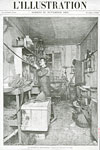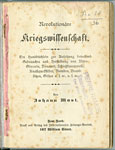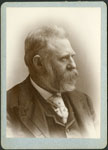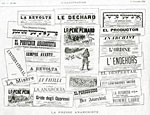Anarchist Assaults
Introduction
 A series of bloody assaults by anarchists spread great panic in fin-de-siècle Europe. For the first time in history, they aimed at civilians, alongside monarchs and other authorities. The purpose behind this violent practice was that such acts of terror would stir the masses to rebellion and prove the impotence of the state. Attacks on monarchs - the murder of the legendary Empress Sissi of Austria was the first 'successful' attempt - appear to have been an exclusively Italian activity. At the time a great many escapees from Italy roamed through Europe and America, on the run because of political repression, social inequality, and poverty. Perpetrators, both Italian and non-Italian, were usually on the run for something, down-and-out, far from their native ground, and in most cases scions of multi-problem families (in today's terminology). The contemporary forensic psychiatrist Emmanuel Régis (les Régicides, 1890) and the criminologist Cesare Lombroso (Gli Anarchici, 1894) characterized the perpetrators as mentally retarded, criminals, or indirect suicide squads.
A series of bloody assaults by anarchists spread great panic in fin-de-siècle Europe. For the first time in history, they aimed at civilians, alongside monarchs and other authorities. The purpose behind this violent practice was that such acts of terror would stir the masses to rebellion and prove the impotence of the state. Attacks on monarchs - the murder of the legendary Empress Sissi of Austria was the first 'successful' attempt - appear to have been an exclusively Italian activity. At the time a great many escapees from Italy roamed through Europe and America, on the run because of political repression, social inequality, and poverty. Perpetrators, both Italian and non-Italian, were usually on the run for something, down-and-out, far from their native ground, and in most cases scions of multi-problem families (in today's terminology). The contemporary forensic psychiatrist Emmanuel Régis (les Régicides, 1890) and the criminologist Cesare Lombroso (Gli Anarchici, 1894) characterized the perpetrators as mentally retarded, criminals, or indirect suicide squads.
'Laboratory of the anarchist'
 The outbreak of radical violence started with the invention of dynamite (patented in 1867). In 1885 and 1886 an anarchist cookbook followed. It was compiled by Johann (John) Most (1846-1906), nicknamed Dynamost. Most of these originated in Germany, and the emigrants established and led the anarchist periodical Freiheit in London and later emigrated to the US, where Freiheit was to be continued.
The outbreak of radical violence started with the invention of dynamite (patented in 1867). In 1885 and 1886 an anarchist cookbook followed. It was compiled by Johann (John) Most (1846-1906), nicknamed Dynamost. Most of these originated in Germany, and the emigrants established and led the anarchist periodical Freiheit in London and later emigrated to the US, where Freiheit was to be continued.
Dynamite, anger, and hunger for revenge were the three most important ingredients in the anarchist laboratory. Collective anger was prolonged by the execution of four anarchists arrested at random after the bombing at Haymarket, Chicago, in 1886. Images of this execution and its numerous commemorations were spread in America and Europe. Time and again new assaults and consecutive executions took place. The person to be hanged or guillotined cried out for revenge from the scaffold, and his call was disseminated by the powerful internationalist anarchist press and heard by anarchists in all countries.
 The theoretical basis for killing men in the street was phrased most powerfully by the Sicilian anarchist Paolo Schicchi (1865-1950) in Pensiero e dinamite (Thought and Dynamite), who latched on to Darwinist ideas:
The theoretical basis for killing men in the street was phrased most powerfully by the Sicilian anarchist Paolo Schicchi (1865-1950) in Pensiero e dinamite (Thought and Dynamite), who latched on to Darwinist ideas:
'Women, elderly people, children, must all be smothered in blood. When two elements are struggling to survive, one must wither away to let the other live in peace ... in our case also, this is an imperative of Darwinism.'
Repository of Anarchism
The IISH is the most important worldwide repository of anarchist records and papers. The most unlikely titles and unique editions of periodicals and pamphlets produced in obscure printing houses all over the world are included in the collections. Publications from the 19th century, the heyday of anarchist assaults, are abundant. The archives of Alexander Berkman, who committed an assault himself, and of the editorial board of the anarchist newspaper Freedom are also at the IISH. Many photographs, flyers, posters, and first editions of publications by anarchists complete the collections. For a brief overview of anarchist collections at the IISH, go to web guide Anarchism.
 A mass of information on the events is available, both printed and on the Internet. The unique contemporary materials in the collections of the IISH are the focus of attention here. The most discussed assaults between 1892 (Paris) and 1909 (Argentina) are covered. To obtain copies, go to Services for fees and procedures.
A mass of information on the events is available, both printed and on the Internet. The unique contemporary materials in the collections of the IISH are the focus of attention here. The most discussed assaults between 1892 (Paris) and 1909 (Argentina) are covered. To obtain copies, go to Services for fees and procedures.
Go to
• Paris 1892-1894
• Alexander Berkman / Henry Frick, 1892
• Barcelona 1893-1897
• Luigi Lucheni / Empress Elisabeth Sissi of Austria-Hungary, 1898
• Gaetano Bresci / Umberto I of Italy, 1900
• Leon Czolgosz / US president McKinley, 1901
• Simon Radowitzky / Ramón Lorenzo Falcón, 1909
